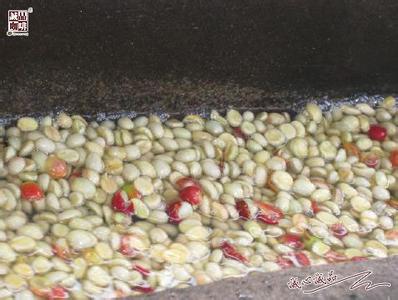How to treat Yunnan coffee beans
As the harvest season is almost over, I would like to add an overview of the coffee processing process. In this blog post, I will introduce to you the steps of wet treatment in Yunnan after coffee picking.
After harvest, the berries are either sent directly to the pulp collector (if the harvest is done well), or concentrated in a siphon tank filled with water. The berries are washed and separated in this jar. The stone sank to the bottom of the jar and was picked up by hand when the jar was emptied. Lighter berries float on the water and are removed with a hedge along with leaves and twigs. The berries suspended in the water are then recovered by a siphon and transported to the pulp collector.
The purpose of removing the pulp is to separate the pulp from the seed coat of coffee beans. The pulp is removed by squeezing the berries. Because ripe berries contain a lot of moisture, peeled coffee beans can easily pop out when the berries are squeezed.
The next step is to remove the mucus, which aims to remove the residue of the mesocarp that clings to the seed coat after the pulp has been removed (see the illustration of the various parts of the coffee berry). Because the mucus is insoluble in water and tightly attached to the seed coat, it cannot be removed by simple cleaning, so it either needs to be cleaned after fermentation or can be removed by strong friction in an equipment called a mucus remover.
In Yunnan, this process is mainly accomplished by natural fermentation. The term fermentation is not 100% accurate because there is no biochemical reaction inside the coffee beans. It is more appropriate to call this process the use of biochemical reaction or hydrolysis to remove mucus. This reaction is caused by natural enzymes in coffee berries.
The fermentation time varies from 6 hours to 72 hours, depending on the temperature, the amount of mucus and the concentration of digestive enzymes. Put the coffee in a fermentor until the mucus is completely decomposed and the beans can be washed.
The key to ensuring the quality of coffee is to stop fermentation at the right time, because excessive fermentation can lead to the emergence of so-called smelly coffee beans. If the fermentation is insufficient or too slow, butyric acid or propionic acid will be produced, both of which will adversely affect the quality of coffee.
The fermented coffee with skin needs to be cleaned immediately after the completion of the fermentation process to terminate the process. However, after removing the mucus and before cleaning, it may be necessary to soak the coffee with skin in clean water for 12 to 24 hours to reduce the bitter taste of the coffee drink. (this article is reproduced)

Important Notice :
前街咖啡 FrontStreet Coffee has moved to new addredd:
FrontStreet Coffee Address: 315,Donghua East Road,GuangZhou
Tel:020 38364473
- Prev

The Origin of Coffee Coffee is traced back to the main producing countries.
The word coffee [1] comes from the Greek word Kaweh, meaning strength and enthusiasm. Coffee tree is an evergreen shrub of Capsaceae. Daily coffee is made from coffee beans combined with a variety of cooking utensils, and coffee beans refer to the nuts in the fruit of coffee trees, which are then roasted with appropriate roasting methods. Legends about the origin of coffee vary, but mostly because of it
- Next

Which coffee farms are more famous and better known?
There are many coffee estates in the world, such as Fire Phoenix Manor, etc., but few of them are well-known internationally. Overall, Honduran coffee has a good reputation and is suitable for blended coffee. Coffee in Honduras is imported from El Salvador. High acidity is produced in Honduras
Related
- Does Rose Summer choose Blue, Green or Red? Detailed explanation of Rose Summer Coffee plots and Classification in Panamanian Jade Manor
- What is the difference between the origin, producing area, processing plant, cooperative and manor of coffee beans?
- How fine does the espresso powder fit? how to grind the espresso?
- Sca coffee roasting degree color card coffee roasting degree 8 roasting color values what do you mean?
- The practice of lattes: how to make lattes at home
- Introduction to Indonesian Fine Coffee beans-- Java Coffee producing area of Indonesian Arabica Coffee
- How much will the flavor of light and medium roasted rose summer be expressed? What baking level is rose summer suitable for?
- Introduction to the characteristics of washing, sun-drying or wet-planing coffee commonly used in Mantenin, Indonesia
- Price characteristics of Arabica Coffee Bean Starbucks introduction to Manning Coffee Bean Taste producing area Variety Manor
- What is the authentic Yega flavor? What are the flavor characteristics of the really excellent Yejasuffi coffee beans?

